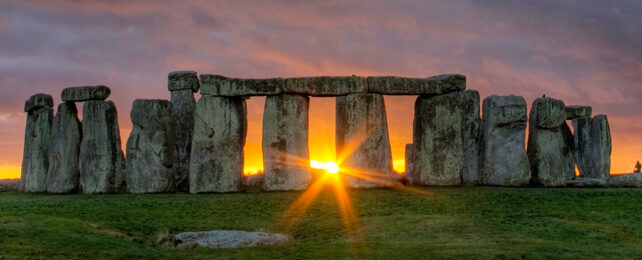Rising from the flat expanse of Salisbury Plain in Wiltshire, England, the monoliths at the center of ancient wonder that is Stonehenge echo an era we've long forgotten.
Their very presence invites speculation over some grandiose purpose. Far from a random jumble of boulders, these large stones were quarried in a far-off land, dragged day and night onto sacred ground, to be arranged with a precision that feels almost clockwork.
As dawn breaks on summer solstice and the Sun boldly climbs above the Heel Stone that lies northeast of the circle, shining its rays directly into the heart of Stonehenge, it's hard to deny that the monument was designed with the turning-point of the seasons in mind.
To a number of scholars, there's more to Stonehenge's design than a symbolic reverence for the changing lengths of days. It's a timekeeper of some detail, a 'Neolithic computer' even, tasked with dividing up the year around less significant events.
Last year, Bournemouth University archaeologist Tim Darvill published his claim that the monument operated as some kind of 'perpetual calendar', one based on a solar year equivalent to 365.25 days.
Now, Polytechnic University of Milan mathematician Giulio Magli and astronomer Juan Antonio Belmonte from the Institute of Astrophysics of the Canary Islands, Spain, have countered Darvill's claim, stating it is based on "a series of forced interpretations, numerology, and unsupported analogies with other cultures".
What we think of as Stonehenge is really a small part of the total archaeology at the site. Long before the famous stones were put into place, it was an important burial ground for cultures near and far.
From around 3,000 BCE, over many generations, a series of constructions gradually transformed the flat plain. A large mound was dug. Stones were brought in from a site 230 kilometers (about 140 miles) to the west to create what is now known as the bluestone circle.
Around and within these, a series of so-called sarsen megaliths were likely dragged from a quarry 25 kilometers (15 miles) to the north, forming a large outer circle and two 'horseshoe' structures at the center.
Given these sarsen stones all came from the same source, it's likely they were put together at the same time, suggesting to Darvill that they were intended to work as a single unit.
From there it was a matter of looking at the positions and alignments of the sarsen lintels – the 30 horizontal stones that form the tops of the outer stone circle – which when multiplied by 12 would give 360. Add the 5 stones of one of the inner horseshoes and you get 365 – the number of days in a typical year.
Four 'station stones' imply the addition of a leap day every four years, a consideration that was added by the builders as a means of refining a timekeeping model that Darvill claimed was based on the Egyptian civil calendar.
Magli and Belmonte have some issues with Darvill's reasoning, addressing his supporting claims in terms of numerological, archaeoastronomical, and cultural arguments.
Accusations of applying numerological 'pseudoscience' aren't uncommon in archaeology, with assertions it's easy to find significant looking numbers in ancient constructions, if you look hard enough.
As stated by the authors, the critical number 12 used by Darvill to multiply the number of lintels isn't reflected anywhere in Stonehenge's structure. There is also a variety of other numbers represented throughout the structure, such as in its portal, which seem to be ignored.
Specific figures aside, the structure itself is unlikely to have ever been precise enough to distinguish subtle changes in the Sun's daily movement, according to Magli and Belmonte. Matching sunrise on a specific day with a specific stone is one thing. Imagining a hypothetical method and devices that could be used with the stones to pinpoint a day of the year is another.
As for the calendar's Egyptian origins (and improvements upon), it's a speculation that would need some pretty convincing evidence, according to Magli and Belmonte. The Egyptians themselves built nothing that might mark off the days to such precision, after all, and wouldn't even consider how to account for a leap year for at least another 2,000 years.
Lastly, it's more likely than not that, like most Neolithic cultures, Stonehenge's architects would have adhered to a lunar calendar. While solar alignments might have played a role in anchoring significant lunar dates, determining these alignments would need some pretty precise handiwork.
As Magli and Belmonte conclude, "Stonehenge is, evidently, not such a device!"
It's important to keep in mind that Darvill might have valuable responses to the critiques, which could yet support his Stonehenge calendar hypothesis. Debates like these are the very cornerstone of science, after all.
In any case, he won't be the last to contemplate the true purpose of the stone columns rising from a plain in Salisbury, UK, that have stood in defiance of time for thousands of years.
This critique was published in Antiquity.
